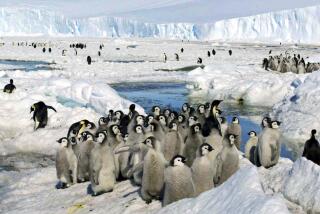Antarctica Is No Place to Get Cold Feet : Science: Geologist Bruce Marsh and his team prepare for the worst as they embark on trip to study the creation of continents.
- Share via
BALTIMORE — Bruce Marsh often finds his thoughts drifting to two Antarctic explorers who raced each other to the South Pole nearly a century ago.
One, Roald Amundsen, was a Norwegian--meticulous, disciplined and supremely confident. The other, an Englishman named Robert Scott, was arrogant, ill-prepared and close-minded. Amundsen triumphed. Scott and his crew perished on the Antarctic ice.
Marsh, a geologist at Johns Hopkins University, and two graduate students will step from a helicopter and onto the Antarctic plains, where, for a month, they will fend for themselves while conducting their geologic survey. Naturally, they lean toward the Amundsen example.
“One of the most memorable moments you’ll ever know is when the helicopter takes off and the sound of its blades is suddenly replaced by the howling wind,” Marsh, 45, said in a recent interview. “When that happens, you don’t want to be thinking this is different from what you imagined. You don’t want it to be different, to be colder or windier. You want it to be exactly the way you thought it would be.”
So, in Amundsen fashion, Marsh, 45, a tall, endlessly enthusiastic man with a long beard and egg-shaped glasses, has schooled himself in Antarctic conditions and carefully considered appropriate clothing and equipment so that he isn’t caught by surprise. “The last thing you want,” said Marsh, who is on sabbatical in Maine this year, “is to find yourself out there with cold feet.”
The polar explorers, he continued, proved that you can survive in the Antarctic. But that, of course, isn’t his only goal.
“You want to also have the luxury to have peace of mind to be comfortable and relax so you can do your science,” he said.
His project will be among 120 conducted by scientists in Antarctica during this year’s summer season. Temperatures will generally hover from 0 to 20 degrees Fahrenheit. He and his crew will fly Dec. 28 to the Antarctic’s McMurdo Sound where the National Science Foundation, the benefactor of Marsh’s three-year project, operates its base.
The scientists will be outfitted, receive some survival and rock-climbing training, and do an overnight tryout. They will also be granted four or five hours of helicopter time to pick out the exact spot in the so-called “Dry Valley”--about 60 miles from the U.S. station--where they will make camp.
They must be near a water source--an ice field or snowy area. Because of their particular interest--the formation of continental shelfs--Marsh’s team also must be near accessible cliffs and rock formations. Their work may cast further light on the creation of continents and the beginnings and evolution of life on Earth.
Once in the field, the Marsh team will be asked to radio the base station every day. The helicopter will return once before the evacuation at the end of January to move the team to another location of its choosing.
The helicopter’s time is rigidly scheduled. That’s one reason that people going into the interior of the continent are asked to have their wisdom teeth taken out before they arrive--to minimize the need for an emergency trip to the dentist.
Marsh grew up in the punishing winters of northern Michigan. He says that as remote as the Antarctic is, the conditions there may not be the worst he will have faced. “The Aleutians have some of the worst elements in the world,” he said. “There are only six sunny days there a year. Otherwise, it’s lots of rain, fog, wind and mist.”
In preparation for one trip to the Aleutians, Marsh visited a camping equipment store, where he was guaranteed that one particular tent could withstand winds anywhere in the world.
On the Aleutian Islands, the tent didn’t last two days. Marsh and his crew were exposed to the full force of the wind and rain. One member of the party was lifted off his feet and deposited 10 feet away before they all found safety between two lava flows.
“We have a motto now,” Marsh said. “We take no one’s word for anything.”
That is why even though the National Science Foundation will provide all clothing and equipment, Marsh is interviewing other scientists who have spent time in the Antarctic to borrow ideas about what works and what doesn’t.
Compared to the Aleutians, the Antarctic may seem a vacation spot. There is almost no precipitation in the Dry Valleys, one of its attractions to Marsh’s geology party. The surface is always in perfect shape. “There’s no vegetation, very little erosion. Because there’s no rain, there’s no frost heaving. No roots grow into the rocks and there’s no acid. It’s like a lunar surface.”
The National Science Foundation has operated a station in the Antarctic continuously for 36 years. In the history of U.S. scientific expeditions to the Antarctic, there have been 55 deaths, according to Guy Guthridge, a spokesman for the National Science Foundation’s polar program. Most were related to plane crashes or accidents involving heavy machinery--the sort of mishaps that can occur anywhere. Only a few occurred in the field and resulted from miscalculation or poor preparations.
But if Marsh and his team need a further reminder, there is one at McMurdo--a hut Robert Scott used at the start of his expedition. He was never able to return to it.
More to Read
Sign up for Essential California
The most important California stories and recommendations in your inbox every morning.
You may occasionally receive promotional content from the Los Angeles Times.










